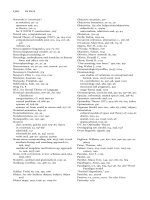LINGUISTICS
Bạn đang xem bản rút gọn của tài liệu. Xem và tải ngay bản đầy đủ của tài liệu tại đây (82.55 KB, 12 trang )
LINGUISTICS-Graduation
-----------o0o-----------
PART 1: NATURAL OF HUMAN LANGUAGE
1-What is a language? _P12
Language is defined as any particular system of human communication
2-What is the language function? _P20
There are 2 different types of language function:
-A biological function is the contribution of a part to the maintenance of the whole
organism
-The mathematical function is often related to functional variety of language
3-What is linguistics? _P33
Linguistics is the study of language as a system of human communication. It is also
considered as the scientific study of language
4-What are the branches of linguistics? _P35
-Phonology is the study and identification of the meaningful sounds of a language
-Phonetics is the study of all speech sounds and the ways in which they are produced
-Morphology is concered with the units, called morphemes, that carry meaning in a
language
-Syntax refers to the relations among word elements in a sentence
PART 2: GRAMMTICAL ASPECTS OF LANGUAGE
I-PHONETICS AND PHONOLOGY
1-What is phonetics? _P43
Phonetics can be defined as the study of how speech sounds are produced, transmitted
and perceived
2-What is the difference between the two terms of phonetics and phonology? _P45
-Phonetics is the study of all speech sounds and the ways in which they are produced
-Phonology is the study and identification of the distinctive units of sound in language:
the phonemes
3-How many stages are there in the speech chain? _P45
There are three stages in the speech chain:
-The first stage may be said to be psychological
-The second stage may be said articulatory and physiological
-The third stage may be physical and acoustic
4-Present the four stages of the vocal cords? _P47
-Wide apart: the vocal cords are wide apart for normal breathing and usaully during
voiceless consonants
1
-Narrow glottis: if air is passed through the glottis when it is narrowed, the result is a
fricative sound for which the symbol is h. The sound is not very different from a whispered
vowel. It is called a voiceless glottal fricative
-Position for vocal cord vibration: when the edges of the vocal cords are touching or
nearly touching, air passing through the glottis will usually cause vibration which results in
voiced sound
-Vocal cords tightly closed: the vocal cords can be firmly pressed so that air cannot pass
between them. When this happen in speech we call it a glottalstop or glottal plosive
5-What are the differences between vowels and consonants? _P49
Major differences between vowels and consonants
Vowels Consonants
Are produced with relatively little
obstruction in the vocal tract
Are produced with a narrow or
complete closure in the vocal tract
Are more sonorous Are less sonorous
Are voiced Are either voiced or voiceless
Are syllabic Are generally not syllabic
6-What is a vowel? _P49 How can we classify the vowels in English language? _P49-51
A vowel is a sound in the production of which the air passed through the mouth is free
In the English language vowels can be classified into pure vowels and diphthongs:
-A pure vowel (monophthong) is an unchanging sound in the pronunciation of which the
organs of speech do not perceptibly change the position throughout the duration of the vowel
-A dipthong is a combination of two vowels pronounced within one syllable
*Classification of vowels and diphthongs
VOWELS DIPHTHONGS
centring closing
ending in ending in I ending in u
Position
of tongue
Height of
tongue
FRONT CENTRAL BACK
CLOSED
(high)
/i:/
/I/
/u:/
/u/
Mid Open
(mid)
/e/ /3/
/ / /^
/
/^/
OPEN
(low)
/ / /o:/
/o/
/a/
7-What is a consonant? _P51 -What are the types of consonants? _P53
2
A consonant is a sound in the production of which an obstruction is formed in the mouth
by the active organs of speech
The types of consonants:
-According to the organs of articulation we can distinguish seven main classes of
consonants:
+Labial or lip sound, which may be divided into:
*Bi-labial, namely sounds articulated by the two lips, and
*Labio-dental, namely sounds articulated by the lower lip against the open teeth
+Dental, namely sounds articulated by the tip of the tongue against the upper teeth
+Alveolar, namely sounds articulated by the tip or blade of the tongue against the
teeth ridge
+Palato alveolar, namely sounds which have alveolar articulation together with a
simultaneous raising of the main body of the tongue towards the roof of the mouth
+Palatal, namely sounds articulated by the tongue against the hard palate
+Velar (soft palate), namely sounds articulated by the back of the tongue against the
soft palate
+Glotal, namely sounds articulated in the glottis (the opening between the vocal
cords is known as glottis)
-According to the manner in which the organs articulate them, we distinguish seven main
classes:
+Plosive (stop sounds / explosive sounds), the air stream is completely stopped for a
moment, after which it is followed to rush out of the mouth with an explosive sound
+Affricative is a combiantion of a plosive consonant with an immediately following
fricative sound
+Nasal is the sound in the production of which all the air from the lungs escapes
down the nose and not through the mouth at all
+Lateral is the sound formed by the tip of the tongue firmly pressed against the teeth
ridge or the teeth so that the air can escape at one or both sides of the tongue
+Rolled is the sound in the production of which the tip of the tongue vibrates in the
stream of air
+Fricative is the sound formed by a narrowing of the air passage at some point so
that the air in escaping makes a kind of hissing or buzzing
+Semi-vowel is a gliding sound in which the speech organs start at or near a “close”
vowel and immediately move away to some other vowels
3
*The English of consonants
Labial Dental Alveolar
Palato-
alveolar
Palatal Velar Glottal
Bilabial
Abial-
dental
Plosive p b t d k g
Affricative
Nasal m n
Lateral l
Rolled r
Fricative f v s z h
Semivowel w j
8-What is a phoneme? _P59
A phoneme is defined as the smallest distinctive unit of sound in a language
9-What are the units larger than the phoneme? _P63
The units are larger than the phoneme include: -syllable; -word; -stress-group; -foot;
-tone-group
10-What is an allophone? _P60
When the difference between two similar sounds is completely predictable from the
phonetic contexts in which they occur are called allophones
11-How is the syllable defined? _P72
The syllable may be defined as one or more speech sounds forming a word or part of a
word, containing one vowel sound, with or without a consonant or consonants, and uttered at
a single effort
12-What syllable is called phonetically open syllable? Closed syllable? _P73
-An open syllable is a syllable which ends in a vowel
-A closed syllable is a syllable which ends in a consonant
13-What is the difference between weak and strong syllables? _P74
-A strong syllable will have as its center one of the vowel phonemes, but not /ô/
-A weak syllable can have four types of center: the vowel /ô/, a close unrounded vowel i:
and I, a close back rounded vowel /u:/ and /u/, a syllabic consonant
14-How is word-stress defined? _P75
Word-stress is defined as the prominence given to certain syllable(s) in a word by the
use of greater breath force
15-What is sentence stress? _P81
Sentence stress is a prominence with which one or more words in a sentence are
pronounced (as compared with the other words of the same sentence)
4
16-How do you understand the term intonation? _P88 -What is a tone language? _P88
-What is an intonation language? _P88
-Intonation can be said to be the combination of speech melody, sentence stress, tempo
and timbre
-Tone language: Languages that use the pitch of individual syllables to contrast
meanings are called tone languages
-Intonation language: Languages that use pitch syntacticallyor in which the changing
pitch of a whole sentence otherwise important to the meaning are called intonation
languages
17-What are the uses of the five basic tones in English? _P89-90
The uses of the five basic tones in English are:
-The fall is used in simple statements of fact, special questions, commands,
exclamations, offers or suggestions to do something
-The rise is used in general questions, requests, greetings, a series of special questions
in a questionnaries, question tags, incomplete parts of the sentence
-The fall-rise can be used for “limited agreement and response with reservations, the
fall-rise also expresses politeness, apology, concern, uncertainty, disagreement…
-The rise-fall might be used to express attitudes both pleasantand unpleasant, ranging
from irony to sarcasm, from being pleasantly impressed to admiration
18-What is a tone unit? _P90
A tone unit may be a word, a phrase, a clause or a simple sentence
19-What are the functions of the English intonation? _P92
The intonation performs the following functions: emotional, grammatical, information
structure, textual, psychological and indexical
II-GRAMMAR
1-What is grammar? _P97
Grammar is composed of morphology and syntax
2-What are the types of the grammar you have learned? _P97
There are many types of grammar:
-The first types is called traditional grammar. This kind of grammar was often notional
and prescriptive in their approach
-The second type is prescriptive grammar. The aims of the prescriptive grammars were
to reduce the English language to rules and set tup a standard of correct usage
-The third type is descriptive / structural grammar – an approach that describes the
grammatical instructions that are uesed in a language, without making any evaluative
judgements about their standing in society
5









